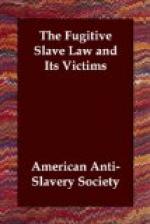declared illegal; thereupon another habeas corpus
was issued, which the Marshal refused to obey; when
he was fined $50, and imprisoned for contempt.”
Even United States Commissioner Pendery, before
whom the case was brought as that of a fugitive
slave, pronounced the girl free, and she was
placed in the care of a guardian. The United States
Marshal being taken by habeas corpus before
Judge McLean, of the United States Supreme Court,
was set at liberty, Judge McL. alleging that
the proceedings in the State Court were null
and void!
GEORGE CLARK, a colored boy, eighteen years of age, in Pennsylvania, was decoyed into the house of one Thompson, (February 23, 1855,) where he was seized by three men, one of whom was Solomon Snyders, a well known ruffian and kidnapper in the neighborhood, who said to him, “Now, George, I am going to take you to your master.” The screams of George fortunately brought deliverance to him. The three men were arrested, tried, and sentenced to imprisonment for kidnapping, by the Court of Dauphin County.—Norristown (Penn.) Olive Branch.
The Norristown (Penn.) Olive Branch, (in connection with the last named case,) speaks of a case which had occurred a short time before, under the Fugitive Law, before United States Commissioner McAllister, at Harrisburg, Pennsylvania, and which has not yet been mentioned in this record. A colored man and his wife, with their infant child, were taken, “one morning, very early,” before Commissioner Richard McAllister, and before any counsel could reach the spot the case had been decided against the man and woman; but the babe, having been born in Pennsylvania, they did not “dare to send that” into slavery; “so the only alternative was to take it away from its mother,” which was done, and that evening the man and woman were taken South. No time had been allowed to bring forward witnesses in their behalf, and there was only a single witness against them, and he a boy about seventeen years old, and a relative of the slave-claimant. The woman’s sufferings, on account of the separation from her child, seemed greater than for her own fate. The article from the Norristown paper is in the National Anti-Slavery Standard, June 2, 1855.
GEORGE MITCHELL, a young colored man, at San Jose, California, arrested and taken before Justice Allen, April, 1855, “charged with owing service and labor to one Jesse C. Cooper, of Tennessee.” Mitchell was brought into California by his then owner, in 1849, the year before the enactment of the Fugitive Slave Law. His arrest was made, under a Fugitive Slave Law of California. By habeas corpus the case was carried before Judge C.P. Hester, of the District Court. Mitchell was discharged on the ground (we believe) that the California Law was unconstitutional; also that the proceedings were “absolutely void.” On the 21st April (or May) “another attempt was made




